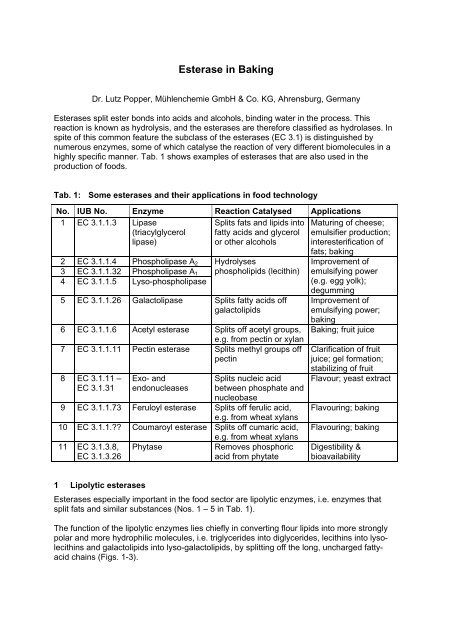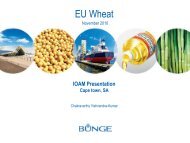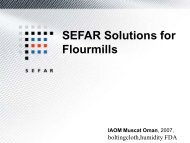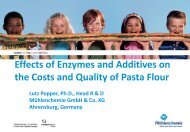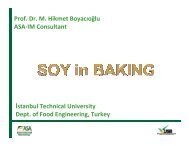Session I - Tech#4 Muhlenchemie
Session I - Tech#4 Muhlenchemie
Session I - Tech#4 Muhlenchemie
Create successful ePaper yourself
Turn your PDF publications into a flip-book with our unique Google optimized e-Paper software.
Esterase in Baking<br />
Dr. Lutz Popper, Mühlenchemie GmbH & Co. KG, Ahrensburg, Germany<br />
Esterases split ester bonds into acids and alcohols, binding water in the process. This<br />
reaction is known as hydrolysis, and the esterases are therefore classified as hydrolases. In<br />
spite of this common feature the subclass of the esterases (EC 3.1) is distinguished by<br />
numerous enzymes, some of which catalyse the reaction of very different biomolecules in a<br />
highly specific manner. Tab. 1 shows examples of esterases that are also used in the<br />
production of foods.<br />
Tab. 1: Some esterases and their applications in food technology<br />
No. IUB No. Enzyme Reaction Catalysed Applications<br />
1 EC 3.1.1.3 Lipase<br />
(triacylglycerol<br />
lipase)<br />
Splits fats and lipids into<br />
fatty acids and glycerol<br />
or other alcohols<br />
Maturing of cheese;<br />
emulsifier production;<br />
interesterification of<br />
2 EC 3.1.1.4 Phospholipase A 2<br />
3 EC 3.1.1.32 Phospholipase A 1<br />
4 EC 3.1.1.5 Lyso-phospholipase<br />
Hydrolyses<br />
phospholipids (lecithin)<br />
5 EC 3.1.1.26 Galactolipase Splits fatty acids off<br />
galactolipids<br />
6 EC 3.1.1.6 Acetyl esterase Splits off acetyl groups,<br />
e.g. from pectin or xylan<br />
7 EC 3.1.1.11 Pectin esterase Splits methyl groups off<br />
pectin<br />
8 EC 3.1.11 –<br />
EC 3.1.31<br />
Exo- and<br />
endonucleases<br />
Splits nucleic acid<br />
between phosphate and<br />
nucleobase<br />
9 EC 3.1.1.73 Feruloyl esterase Splits off ferulic acid,<br />
e.g. from wheat xylans<br />
10 EC 3.1.1.?? Coumaroyl esterase Splits off cumaric acid,<br />
e.g. from wheat xylans<br />
11 EC 3.1.3.8, Phytase<br />
Removes phosphoric<br />
EC 3.1.3.26<br />
acid from phytate<br />
fats; baking<br />
Improvement of<br />
emulsifying power<br />
(e.g. egg yolk);<br />
degumming<br />
Improvement of<br />
emulsifying power;<br />
baking<br />
Baking; fruit juice<br />
Clarification of fruit<br />
juice; gel formation;<br />
stabilizing of fruit<br />
Flavour; yeast extract<br />
Flavouring; baking<br />
Flavouring; baking<br />
Digestibility &<br />
bioavailability<br />
1 Lipolytic esterases<br />
Esterases especially important in the food sector are lipolytic enzymes, i.e. enzymes that<br />
split fats and similar substances (Nos. 1 – 5 in Tab. 1).<br />
The function of the lipolytic enzymes lies chiefly in converting flour lipids into more strongly<br />
polar and more hydrophilic molecules, i.e. triglycerides into diglycerides, lecithins into lysolecithins<br />
and galactolipids into lyso-galactolipids, by splitting off the long, uncharged fattyacid<br />
chains (Figs. 1-3).
Fig. 1: Effect of lipases on triglycerides Fig. 2: Effect of phospholipases on<br />
phosphatidylcholine (lecithin<br />
fraction)<br />
Bread volume [ml/100 g flour]<br />
200<br />
180<br />
160<br />
140<br />
polar lipids<br />
total lipids<br />
non-polar lipids<br />
volume prior to baking<br />
0 200 200 300 400 500 600 700 800 900<br />
1000<br />
Re-added wheat lipid [mg/100 g flour]<br />
Fig. 3:<br />
Effect of galactolipase on<br />
monogalactosyl diglyceride<br />
Fig. 4:<br />
Effect of polar and non-polar<br />
wheat lipids on the volume yield<br />
of defatted wheat flour (modified<br />
from MacRitchie and Gras, 1973)<br />
The resulting structures with a greater affinity with water interact strongly with the proteins of<br />
the gluten. In the dough phase the lipids are already largely associated with the protein, so<br />
after their modification they are already in the right position for an optimum effect on the<br />
protein.<br />
Over the past few years, lipolytic enzymes have steadily gained significance in flour<br />
standardization – especially in the field of baking improvers and baking premixes. In the<br />
premixes these enzymes can partially or wholly replace emulsifiers, making it possible to<br />
reduce dosages, simplify label declarations and cut costs.<br />
A suitable product series for this purpose is Alphamalt EFX. In developing it, Mühlenchemie<br />
took the heterogeneous nature of the wheat lipids into account (Tab. 2).
Tab. 2: Lipids in wheat flour (0.405 % ash)<br />
Total lipids (14 % m.b.) 1,280<br />
Non-polar lipids 457<br />
Polar lipids 823<br />
Phosphatides (lecithin) 250<br />
Phosphatidyl acid 30<br />
Phosphatidyl glycerol 51<br />
Phosphatidyl cholin 27<br />
Phosphatidyl ethanolamine<br />
traces<br />
Phosphatidyl serine 15<br />
Lyso-phosphatidyl cholin 117<br />
Lyso-phosphatidyl ethanolamine 10<br />
Galactolipids 249<br />
Other polar lipids 320<br />
The result is an esterase with which the fatty-acid residues can be split off from a wide range<br />
of substrates. However, the enzyme has a preference for longer chains (over C8), which<br />
means that even in the presence of butter fat there is very little risk of an off-taste caused by<br />
the release of volatile fatty acids.<br />
If an enzyme is to act on the lipids it first has to gain access to them by diffusion. For this<br />
reason the Alphamalt EFX series is most suitable for baking methods with long fermentation<br />
times, e.g. baguettes (as shown for Alphamalt EFX Super in Fig. 5 and 6), although the<br />
effects are already visible with short proof times such as those for split rolls.<br />
Basic treatment:<br />
FAA, 1 SKB/g<br />
ADA, 40 ppm<br />
Asc., 160 ppm<br />
SSL, 0.3 %<br />
0 ppm 10 ppm 25 ppm 50 ppm<br />
743 748 787 856<br />
1.5 h,<br />
normal proof<br />
Volume yield,<br />
mL/100 g flour<br />
803 852 882 935<br />
2 h,<br />
over-proof 1<br />
863 937 965 1015<br />
2.5 h,<br />
over-proof 2<br />
Fig. 5:<br />
Effect of Dosage and Proof Time on Baguette Rolls with<br />
Alphamalt EFX Super
1.5 h,<br />
normal proof,<br />
no EFX Super<br />
1.5 h,<br />
normal proof<br />
2 h,<br />
over-proof 1<br />
2.5 h,<br />
over-proof 2<br />
Basic treatment:<br />
FAA, 1 SKB/g<br />
ADA, 40 ppm<br />
Asc., 160 ppm<br />
SSL, 0.3 %<br />
743 856 935 1015<br />
Volume yield,<br />
mL/100 g flour<br />
Fig. 6:<br />
Effect of Proof Time on Baguette Rolls with Alphamalt<br />
EFX Super (50 ppm)<br />
For applications with short proof times, especially, it is advisable to test combinations with<br />
emulsifiers such as DATEM or SSL. It is often possible to enhance the baking properties or<br />
reduce the dose of emulsifier. With Alphamalt EFX, dough stability and fermentation<br />
tolerance are constantly adjusted to the requirements of the baking process: the longer the<br />
proof time, the more chance Alphamalt has to develop its activity.<br />
So it is that the user has a flexible, adaptable flour improvement system at his disposal that<br />
makes it possible to control dough stability and volume yield.<br />
The dosage is only 5 – 50 ppm (0.5 – 5 g to 100 kg of flour). Large doses should only be<br />
used in conjunction with short proof times. An overdose does not increase the effect. On the<br />
contrary: it may even result in a slight loss of volume yield.<br />
Wheat flour contains about 1.5% lipids (fat-like substances) which fall into two categories:<br />
non-polar lipids that are not miscible with water, and polar lipids. The polar lipids include the<br />
lecithins and compounds of sugars and fats, for instance galactolipids. The effects of polar<br />
and non-polar lipids on the volume yield of flour were already described by MacRitchie and<br />
Gras in 1973. According to these authors it is only the polar lipids that bring about an<br />
increase in volume (Fig. 4).<br />
At first glance it may seem odd that the use of (totally non-polar) fats in baking usually<br />
increases the volume of the baked goods, at least at low dosages (up to about 10%). But we<br />
have to remember that in contrast to the trials that led to Fig. 4, the fat is added to an intact<br />
flour in which polar and non-polar lipids are present in their natural ratio and in their usual<br />
positions. In this case the addition of polar lipids evidently results in increased volume. One<br />
might compare the effect to that of a lubricant that makes the dough more pliant, allowing the<br />
“layers” to slide over each other.<br />
2 Xylanolytic esterases<br />
The function of other esterases consists in splitting off aromatic acid residues from the xylans<br />
(pentosans) of the grain (Fig. 7). In the xylans, ferulic acid and cumaric acid are bound to the<br />
pendant arabinose groups. Through them the xylan chains can be linked with each other and<br />
also with proteins (Fig. 8 and 9). In a reaction called “oxidative gel formation” they thus<br />
increase the water-binding capacity of the dough and result in higher viscosity and reduced<br />
extensibility.
Fig. 7:<br />
Enzymatic hydrolysis sites in<br />
wheat xylan<br />
Fig. 8:<br />
Cross-linking of wheat gluten and<br />
xylan (modified from Hoseney<br />
and Faubion, 1981)<br />
Fig. 9:<br />
Interaction of feruloyl side-chains in<br />
arabinoxylan (modified from Williamson et al.,<br />
1998)<br />
Splitting of the bonds with xylan by the esterases leads to a breakdown of gel-forming<br />
structures and thus to softening of the dough. Single released molecules of these acids are<br />
important precursors of flavour, for example in the maturing of sour dough and also in the<br />
biochemical (“natural”) synthesis of vanilla. A further application is total liquefaction, for<br />
example in the production of ethanol from grain.<br />
A ferulic acid esterase (FAE) from Streptomyces werraensis is described by José-Luis Copa<br />
Patiño et. al. When developing this enzyme for marketing we found – not surprisingly – that<br />
the micro-organism produces a large number of ligno- and hemicellulolytic enzymes (Tab. 3)<br />
of which very few had so far been investigated for their effect on dough and baking<br />
properties.
Ferulic acid esterase will shortly be available commercially as Alphamalt FSR. Its main<br />
function will lie in optimizing the rheological properties of dough (Fig. 10) and in reducing the<br />
cost of enzymes through combination with other xylanolytic enzymes.<br />
160<br />
Extensibility L (mm)<br />
150<br />
140<br />
130<br />
120<br />
110<br />
100<br />
90<br />
80<br />
0.00 0.05 0.10 0.15 0.20 0.25<br />
FAE dosage (%)<br />
Fig. 10: Effect of feruloyl esterase (crude extract) on<br />
the extensibility in the alveogram<br />
Tab. 3: Enzymatic activity in the culture supernatant of Streptomyces werraensis<br />
UAH 44 in various different nutrient media<br />
Substrate<br />
Enzyme<br />
Medium<br />
1 2 3 4 5 6 7 8 9 10<br />
AZCL-amylose Amylase + - - + - + ± ++++ - -<br />
AZCL-arabinan (debranched) Endo-1,5-a-L-arabinase + ++ + +++++ +++ +++ +++ +++ ++++ ++++<br />
AZCL-arabinoxylan (wheat) Endo-xylanase ++++ ++++ ++++ +++ +++ +++ +++ ++ +++ +++<br />
AZCL-HE cellulose Endo-cellulase - + - ++ - - - - +++ +<br />
AZCL-curdlan Endo-1,3-b-glucanase - +++ ± +++ + + + ++ ++++ +++<br />
AZCL-dextran Endo-1,6-a-glucanase - - - - - - - - - -<br />
AZCL-galactan (potato) Endo-1,4-b-galactanase - ± - ++++ ++ ++ ++ + ++++ +++<br />
AZCL-galactomannan b-mannanase - - - + - - - - + ±<br />
AZCL-b-glucan Malt b-glucanase ++ +++ ++++ +++ ++++ +++ ++++ +++ +++ ++<br />
AZCL-pullulan Limit dextrinase - - - - - - - - - -<br />
AZCL-xylan(oat) Endo-xylanase ++ ++++ ++ ++++++ ++++++ + +++++ ++ ++++++ +++<br />
Skimmed milk Protease - + - +++ +++ - ++ - +++ +++<br />
3 Proteases with esterase activity<br />
Esterase activity is sometimes found in unexpected places – for example in some proteases,<br />
where it is a genuine side activity of the protease molecule. The reason is that the reaction<br />
catalysed by proteases is very similar to ester cleavage (Fig. 9).<br />
Protease: -R 1 CH-CO-NH-CR 2 - + H 2 O ↔ -R 1 CH-COO - + + H 3 N-CR 2 -<br />
Esterase: R 1 -CO-O-R 2 + H 2 O ↔ R 1 -COOH + R 2 -OH<br />
Fig. 11: Representations of reactions catalysed by protease<br />
and esterase<br />
The active centre of serine proteases (subtilisin, trypsin, chymotrypsin) is similar to that of the<br />
lipases. Both contain the same catalytic triad, the amino acid asparagine, histidine and
serine. Papain also has an unspecific effect on lipids, whereas metallo-proteases show no<br />
esterase activity.<br />
The “side effect” plays a certain positive role in the maturing of cheese, where it aids the<br />
development of flavour, but our experience shows that it has no significance at all in baking.<br />
In other applications it can be a great nuisance, for example in the production of precious<br />
vegetable oils, where proteases are used to increase the yield.<br />
4 Phytase<br />
Phytases have found wide applications in feed rations. They degrade phytate, an antinutritive<br />
factor found in cereals and legumes. Phytic acid binds iron, calcium and other<br />
bivalent metal ions, necessary as growth factors and stabilizing agents for enzymes. Phytic<br />
acid also inhibits microorganisms including yeasts, probably by its ion binding properties.<br />
Phytate<br />
Myo-inositol<br />
6-phytase<br />
cereals<br />
H<br />
H 2 O 3 PO<br />
H<br />
H 2 O 3 PO<br />
H<br />
OPO 3 H 2<br />
OPO 3 H 2<br />
H 2 O 3 PO<br />
H<br />
H<br />
OPO 3 H 2<br />
H 6 H 2 O<br />
6 H 3 PO 4<br />
HO<br />
H<br />
HO H<br />
H<br />
OH<br />
OH<br />
HO<br />
H<br />
H OH<br />
H<br />
3-phytase<br />
microorganisms<br />
Fig. 12: Action of phytases on phytate<br />
Phytases split the ester bond between phosphoric acid and inositol, hence depriving phytic<br />
from is ion binding capability (Fig. 12).<br />
Although cereals and legumes also contain phytases, those are not able to break down all<br />
the phytate under normal conditions of processing and digestions. In particular wholegrain<br />
cereal preparations contain a high amount of phytate, which is sterically separated from the<br />
grain’s own phytase (Fig. 13). Furthermore, the level of phytase underlies large natural<br />
fluctuations. Therefore, microbial phytase can be used to improve the nutritive value of food<br />
(and feed) from cereals and legumes.
Phytate<br />
Phytase<br />
2%<br />
13%<br />
85%<br />
8%<br />
15%<br />
34%<br />
40%<br />
Aleuron<br />
Germ<br />
Endosperm<br />
Scutellum<br />
Other<br />
3%<br />
Fig. 13: Distribution of phytate and phytase in wheat<br />
(modified from Zimmermann et al., 2000)<br />
In baking, phytases are able to contribute to dough stability and volume yield, probably due<br />
to a better availability of ions for dough stabilization and microbial (yeast) activity .<br />
5 Other esterases<br />
As far as we know, the enzymes listed as items 6 to 8 in Tab. 1 are not used directly in<br />
baking applications. Although acetyl esterase has a certain effect on wheat xylan, this is<br />
without significance as yet. Nucleases have only been put to technical use indirectly in<br />
baking to produce yeast hydrolysates that have the effect of intensifying the flavour or<br />
replacing salt.<br />
6 References<br />
Copa-Patiño, J.L., Caballero, A., Popper, L., Arenas, M., Soliveri, J., 2007. Empleo de un<br />
complejo enzimático producido por una cepa de actinomicetos en procesos de<br />
panificación. Poster presentation, XXI Congreso Nacional de Microbiología, Sevilla,<br />
Spain, September 17-20.<br />
Hoseney,R.C., Faubion, J.M., 1981. A mechanism for the oxidative gelation of wheat flour<br />
water-soluble pentosans. Cereal Chem. 58(5), 421-424.<br />
MacRitchie, F., and Gras, P. W. 1973. The role of flour lipids in baking. Cereal Chem. 50(3),<br />
292-302.<br />
Williamson, G., Kroon, P.A. and Faulds, C.B., 1998. Hairy plant polysaccharides: a close<br />
shave with microbial esterases. Microbiol. 144, 2011-2023.<br />
Zimmermann, B., Krämer, K., Biesalski, H.-K., Drochner, W., 2000. Zur Bedeutung<br />
pflanzlicher und mikrobieller Phytasen in der Humanernährung. Teil 1: Charakteristik<br />
und Wirkung von Phytinsäure und Phytasen. Ernährungs-Umschau 47(11), 423-427.


